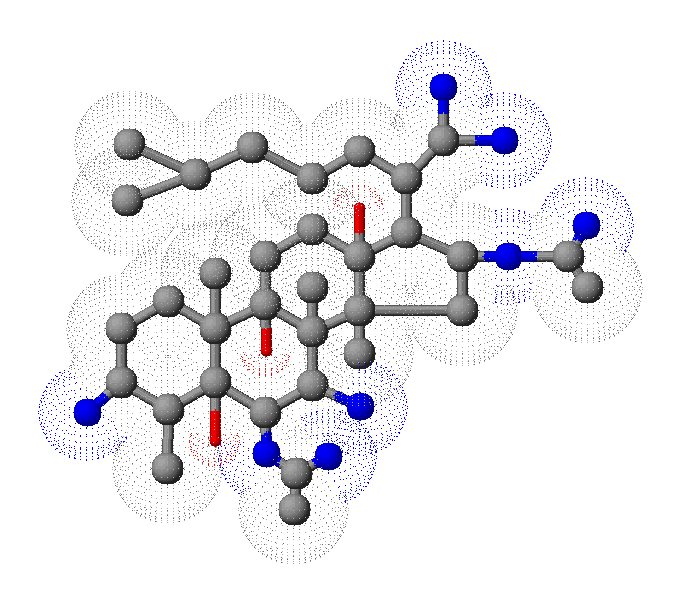Date: 26 November 2013
Secondary metabolites, 3D structure: Trivial name – helvolic acid
Copyright: n/a
Notes:
Species: A. fumigatiaffinis, A. fumigatus, A. novofumigatusSystematic name: 29-Nordammara-1,17(20),24-trien-21-oic acid, 6,16-bis(acetyloxy)-3,7-dioxo-, (4a,6b,8a,9b,13a,14b,16b,17Z)- (9CI)Helvolic acid (6CI, 7CI); (Z)-6b,16b-Dihydroxy-3,7-dioxo-29-nor-8a,9b,13a,14b-dammara-1,17(20),24-trien-21-oic acid diacetate; FumigacinMolecular formulae: C33H44O8Molecular weight: 568.698Chemical abstracts number: 29400-42-8Selected references: Waksman SA , et al. The production of two antibacterial substances, fumigacin and clavacin. Science 96: 202-203, 1942WILLIAMS TI.Biochem J. 1952 Jul;51(4):538-42. Some chemical properties of helvolic acid.OKUDA S, IWASAKI S, TSUDA K, SANO Y, HATA T, UDAGAWA S, NAKAYAMA Y, YAMAGUCHI H. THE STRUCTURE OF HELVOLIC ACID.Chem Pharm Bull (Tokyo). 1964 Jan;12:121-4. Amitani R, Taylor G, Elezis EN, Llewellyn-Jones C, Mitchell J, Kuze F, Cole PJ, Wilson R. Purification and characterization of factors produced by Aspergillus fumigatus which affect human ciliated respiratory epithelium. Infect Immun. 1995 Sep;63(9):3266-71.Toxicity: mouse LD50 intraperitoneal 400mg/kg (400mg/kg) Antibiotics: Origin, Nature, and Properties, Korzyoski, T., et al., eds., Washington, DC, American Soc. for Microbiology, 1978Vol. 3, Pg. 1837, 1978. mouse LDLo intravenous 500mg/kg (500mg/kg) Antibiotics: Origin, Nature, and Properties, Korzyoski, T., et al., eds., Washington, DC, American Soc. for Microbiology, 1978Vol. 3, Pg. 1837, 1978.
Images library
-
Title
Legend
-
Conidial head and brown conidia in a section of a fungus ball caused by Aspergillus niger (H&E, x 400).

-
Double diffusion test for aspergillosis. Central well contains Aspergillus fumigatus antigen and wells in the top and bottom contain control antiserum.
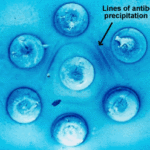
-
Allergic Bronchocentric Granulomatosis. low power. Sections show muscle, lung with acute inflammation and evidence of organisation with early fibrosis. The bronchial wall can be seen with chronic inflammation and many eosinophils.There is a thickened basement membrane. No definite granulomata are seen.

-
Allergic Bronchocentric Granulomatosis. Sections show muscle, lung with acute inflammation and evidence of organisation with early fibrosis. The bronchial wall can be seen with chronic inflammation and many eosinophils.There is a thickened basement membrane. No definite granulomata are seen.
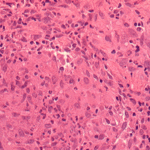
-
Allergic Bronchocentric Granulomatosis. Higher power. Sections show muscle, lung with acute inflammation and evidence of organisation with early fibrosis. The bronchial wall can be seen with chronic inflammation and many eosinophils.There is a thickened basement membrane. No definite granulomata are seen.
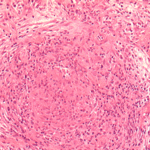
-
Allergic Bronchocentric Granulomatosis. Higher power. Sections show muscle, lung with acute inflammation and evidence of organisation with early fibrosis. The bronchial wall can be seen with chronic inflammation and many eosinophils.There is a thickened basement membrane. No definite granulomata are seen.
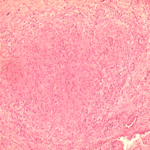
-
Allergic Bronchocentric Granulomatosis. Low power. Sections show muscle, lung with acute inflammation and evidence of organisation with early fibrosis. The bronchial wall can be seen with chronic inflammation and many eosinophils.There is a thickened basement membrane. No definite granulomata are seen.
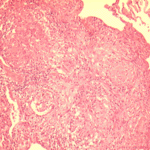
-
Allergic Bronchopulmonary Aspergillosis (ABPA). PT JC
CXR prior to bronchoscopy had shown an opacity just superior to the right hilum, which was felt to represent possibly a fungal plug. Patient was therefore bronchoscoped.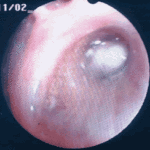 ,
, 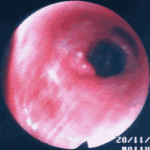
-
Secondary metabolites, Structural diagram. Trivial name – 2-hydroxy-3-methyl-1,4-benzoquinone
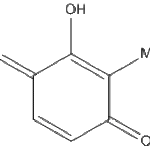
-
Secondary metabolite structure: trivial name – 13-O-Methylviriditin


